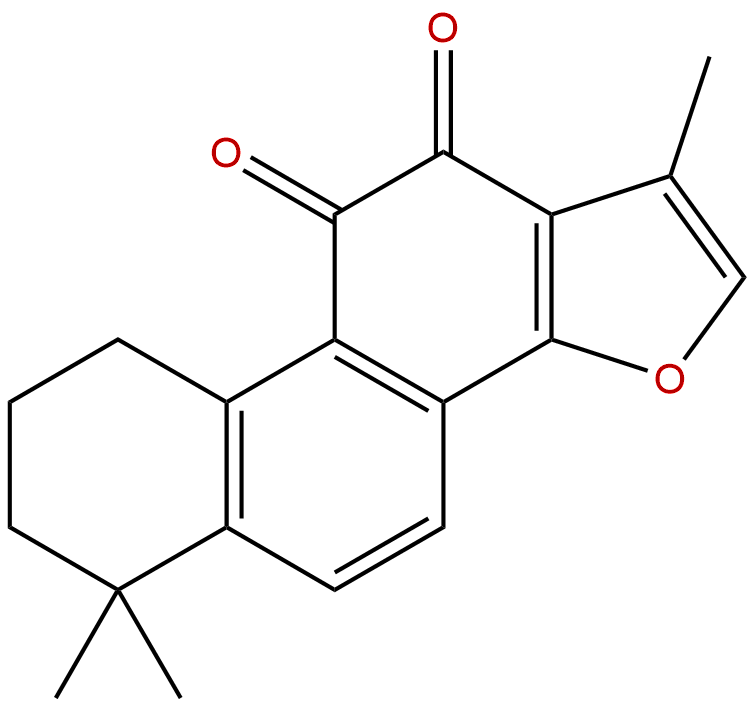
Tanshinone IIACAS No.:568-72-9
|
||||||||||
 |
|
|
||||||||

| Catalogue No.: | BP1362 |
| Formula: | C19H18O3 |
| Mol Weight: | 294.35 |
Product name: Tanshinone IIA
Synonym name: Tanshinone II
Catalogue No.: BP1362
Cas No.: 568-72-9
Formula: C19H18O3
Mol Weight: 294.35
Botanical Source: Pigment from the root of Salvia miltiorrhiza and from Salvia scalarea
Physical Description: Red powder
Type of Compound: Diterpenoids
Purity: 95%~99%
Analysis Method: HPLC-DAD or/and HPLC-ELSD
Identification Method: Mass, NMR
Packing: Brown vial or HDPE plastic bottle
Storage: Store in a well closed container, protected from air and light. Put into refrigerate or freeze for long term storage.
Whenever possible, you should prepare and use solutions on the same day. However, if you need to make up stock solutions in advance, we recommend that you store the solution as aliquots in tightly sealed vials at -20℃. Generally, these will be useable for up to two weeks.
The product could be supplied from milligrams to grams, up to kilograms
Inquire for bulk scale.
Descriptions:
Tanshinone Ⅱ-A is a derivative of phenanthrenequinone isolated from Salvia miltiorrhiza BUNGE, a traditional herbal medicine that is known to induce anti-inflammatory, anti-oxidative and cytotoxic activity; tanshione Ⅱ-A induces HL60 and K562 cellular apoptosis that may be associated with the selective members of caspase family[1]
Acetyltanshinone IIA (ATA), a novel anti-cancer agent, preferentially inhibits cell growth of oestrogen receptor positive (ER+) breast cancer cells and that it is more potent than the commonly used anti-breast cancer agent, tamoxifen; ATA also reduces the mRNA levels of the ERα encoding gene, ESR1, and reduces the transcription of an ER-responsive gene, GREB1.[2]
Tanshinone IIA may inhibit LPS-induced IκBα degradation and NF-κB activation via suppression of the NIK–IKK pathway as well as the MAPKs (p38, ERK1/2, and JNK) pathway in RAW 264.7 cells and these properties may provide a potential mechanism that explains the anti-inflammatory activity of tanshinone IIA.[3]
Tanshinone IIA reduces apoptosis induced by hydrogen peroxide in the human endothelium-derived EA.hy926 cells.[4]
Tanshinone IIA has significant growth inhibition effects on THP-1 cells by induction of apoptosis, and that tanshinone IIA-induced apoptosis on THP-1 cells is mainly related to the disruption of Deltapsim and activation of caspase-3 as well as down-regulation of anti-apoptotic protein Bcl-2, survivin and up-regulation of pro-apoptotic protein Bax, suggests Tanshinone IIA may serve as a potential anti-leukemia reagent.[5]
References:
[1] Sung H J, Choi S M, Yoon Y, et al. Experimental & Molecular Medicine, 1999, 31(4):174-8.
[2] Yu T, Zhou Z, Mu Y, et al. Cancer Lett, 2014, 346(1):94-103.
[3] Jang S I, Kim H J, Kim Y J, et al. Eur J Pharmacol, 2006, 542(1-3):1-7.
[4] Jia L Q, Yang G L, Ren L, et al. J Ethnopharmacol, 2012, 143(1):100-8.
[5] Liu J J, Zhang Y, Lin D J, et al. Oncol Reports, 2009, 21(4):1075-81.
[6] Lei M U, Chen G, Zhang X, et al. Lishizhen Medicine & Materia Medica Research, 2011, 22(10):2338-41.
HPLC of Tanshinone IIA
